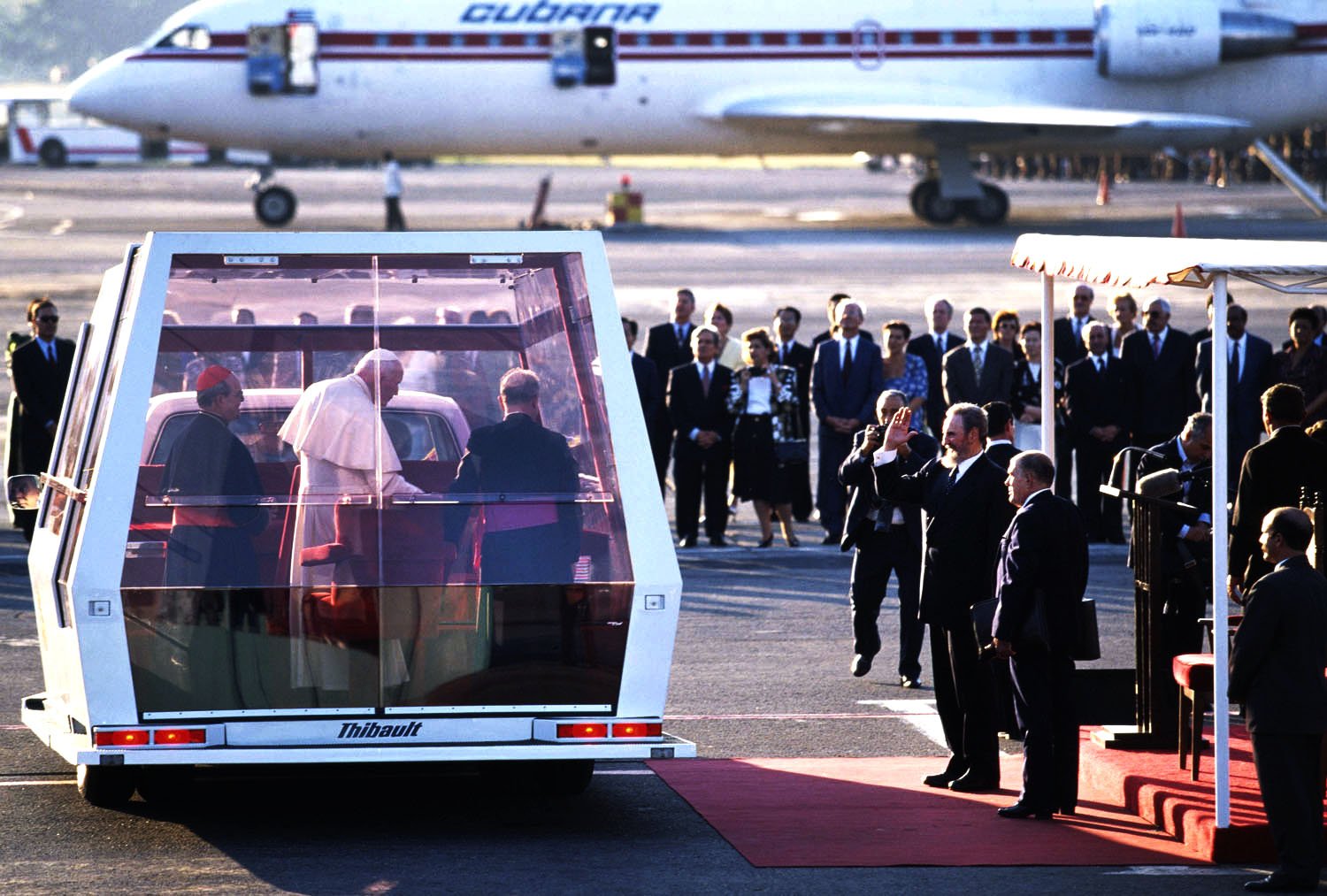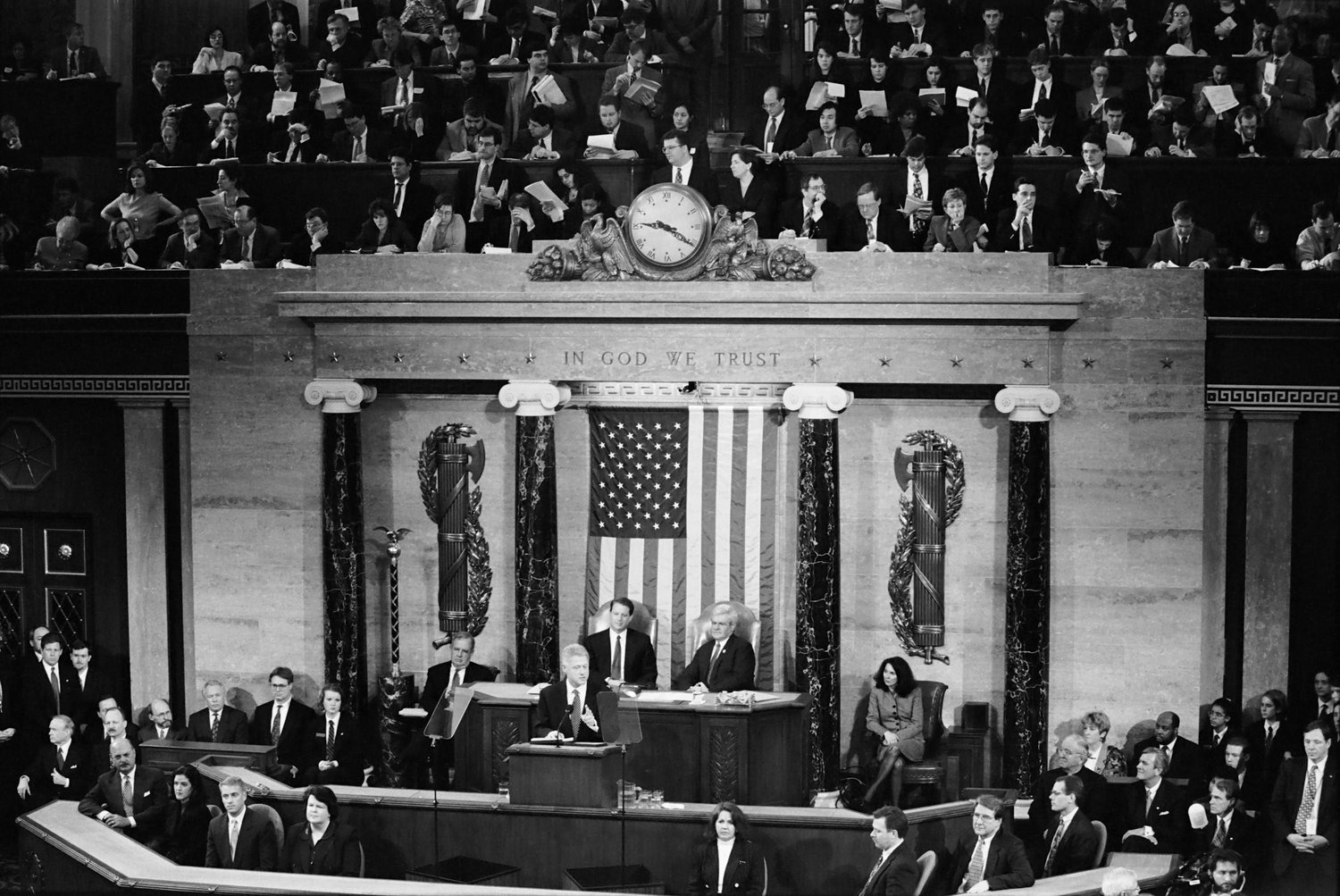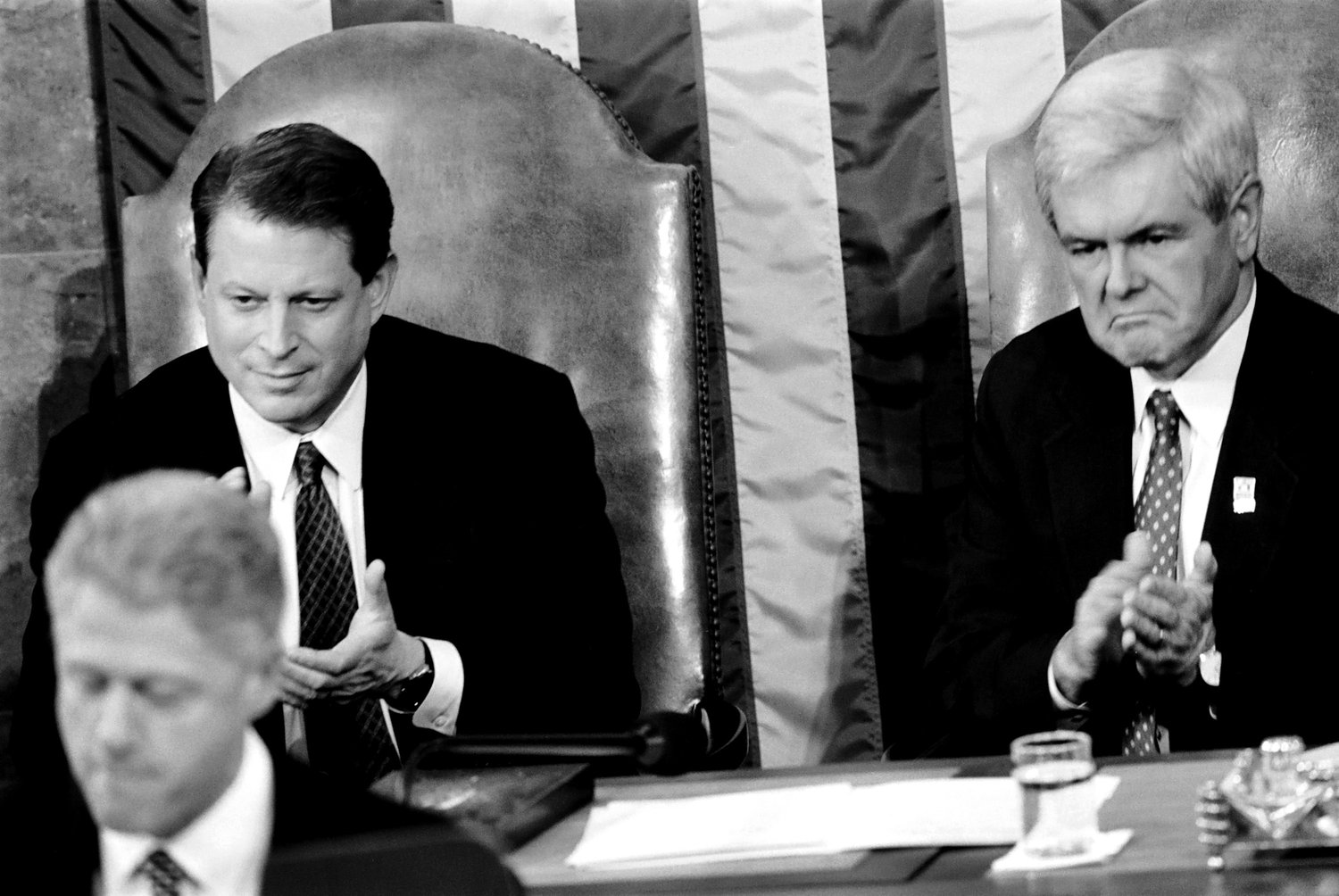Clinton Impeachment
The Impeachment of Bill Clinton
From Havana to the White House
by David Hume Kennerly
Clinton Impeachment

© Center for Creative Photography, Arizona Board of Regents
Pope John Paul II is greeted at the airport by Cuban President Fidel Castro during the arrival ceremony in Havana, Cuba.
Newsweek sent me to Havana in 1998 to cover Pope John Paul II’s visit to Cuba and his meeting with Fidel Castro. Coverage of the pope’s trip was impacted when breaking news from Washington hit the fan. The reports alleged a sexual relationship between President Bill Clinton and White House intern Monica Lewinsky. This was explosive stuff and attention on the pontiff’s trip to Communist Cuba instantly dropped into second place. The skies over Havana were darkened by jets bearing network anchors racing north to cover the scandal. I was not one of them. I stayed to photograph the historic journey of the first pope to visit Cuba.
After the pope departed Cuba, I headed to D.C. to cover Clinton’s State of the Union address. It would be my first time seeing him after news of the scandal. The day before his address to the nation, President Bill Clinton gave his supporters a boost. With First Lady Hillary Clinton by his side in the Roosevelt Room, Clinton looked the TV camera right in the lens and said, “I want you to listen to me. I did not have sexual relations with that woman, Miss Lewinsky. I never told anybody to lie, not a single time, never.” That assertion didn’t hold up that well over the next few months.
I wasn’t present for that aggressive statement but was there for most of the main events that followed. I took the photos in this essay over a year’s time and they document some of the key moments of Clinton’s impeachment.
I was inside the House Judiciary Room for the hearings that led to Clinton being impeached. The day the impeachment articles were approved, Rep. Jim Rogan, one of the Republican Congressmen who was a House Manager, (translation: “Clinton prosecutor”), called me over to where he was sitting in the hearing room. He introduced himself and told me that when he was a kid he sent me a letter while I was President Ford’s chief photographer and asked if I would send him one of my pictures of the president personally autographed by Ford. He added that the letter said that he wanted a genuine signature, not an autopen. “And you didn’t get it?” I said with a laugh. “No, you delivered!” he told me. He added if there was anything he could do for me, let me know.
Without missing a beat I said, “I’d love to get some photos behind the scenes of Chairman Hyde meeting with you and the other managers.” Rogan said he would try, but that all of them would have to agree. He got back to me with a thumb’s up, and I made it into the room where Clinton’s prosecutors were meeting. A few years after that Rogan, who had been a bouncer in a bar at one point, told me that one of his colleagues didn’t want to do it, and he had grabbed the guy by the lapels and screamed at him, “You have to, I owe the guy!” The other congressman was shaken, and said, “OK, if it means that much to you.” Whatever works, and thanks again Jim! I also had good luck gaining exclusive access with Special Prosecutor Kenneth Starr whom I had met when he was on the U.S. Court of Appeals in 1983. Justice Sandra Day O’Connor had introduced us. (Historical footnote: Ken married actress Mel Harris and me in Lafayette Square. Our backdrop was the White House).
It wasn’t until nine months after the Lewinski story broke that Clinton issued his
mea culpa in the East Room on Sept.11,1998. He addressed the annual White House prayer breakfast of more than 100 ministers, priests, and other religious leaders, (and Mrs. Clinton). He said, “I don't think there is a fancy way to say that I have sinned. It is important to me that everybody who has been hurt know that the sorrow I feel is genuine: first and most important, my family; also my friends, my staff, my Cabinet, Monica Lewinsky and her family, and the American people. I have asked all for their forgiveness.”
Contrition aside, Clinton was impeached three months later on Dec. 19, 1998, only the second chief executive in history to achieve that dubious distinction and 130 years after President Andrew Johnson was indicted by the House. I photographed him responding to the moment surrounded by staff and Congressional supporters outside the oval office.
I photographed all the players coming and going during Clinton’s impeachment trial inside the U.S. Senate where the senators were the jury. Because photographers weren’t allowed inside the Senate Chambers it was a bit like covering a bull fight without being in the arena! But there was drama in the hallways also, and I photographed all the major players including Chief Justice William Rehnquist who presided over the trial, Clinton’s lawyers, and other participants. Although she appears on tv screens in the background of some of my photos is the one at the center of it all. To this day I’ve never seen Monica Lewinsky in person.
In the end President Clinton was acquitted by the Senate. He made a statement in the Rose Garden on Feb. 12, 1999. “Now that the Senate has fulfilled its constitutional responsibility, bringing this process to a conclusion, I want to say again to the American people how profoundly sorry I am for what I said and did to trigger these events and the great burden they have imposed on the Congress and on the American people.” When he finished he turned and headed back to the Oval Office, his shadow briefly appearing on the West Wing wall.
The saga is all here in the timeline of my photos. -- David Hume Kennerly
Dates and events for this timeline were developed by CUNY Brooklyn. The full timeline can be viewed here.
State of the Union 1998
On this day, the New York Times reports that Lewinsky met with President Clinton at the White House two weeks after she was subpoenaed to give information in the Paula Jones case. Mr. Clinton makes no mention of the controversy in his State of the Union speech. It is also the day after President Clinton said, "I want you to listen to me. I did not have sex with that woman, Monica Lewinsky. I never told a single person to lie, not a single time, never."

© Center for Creative Photography, Arizona Board of Regents
Vice President Gore and Newt Gingrich Listen to President Clinton's State of the Union Speech

© Center for Creative Photography, Arizona Board of Regents
Hillary Clinton at the State of the Union 1998
On the same day, Kenneth Starr opens a grand jury probe into the Monica Lewinsky allegations. Appearing on NBC's Today, Hillary Rodham Clinton says the controversy has been fabricated by a "vast right- wing conspiracy."
Journalists Outside the Courthouse
President Clinton and Prime Minister Tony Blair
At a news conference on this day, President Bill Clinton says he would never consider resigning because of the accusations against him. "I would never walk away from the people of this country and the trust they've placed in me," he says.
Reporters Cover Prime Minister Tony Blair’s Visit to the White House
Events Developing Out of the Public Eye
April 7, 1998: Bernard Lewinsky lashes out at Kenneth Starr, calling the treatment of his daughter "unconscionable." He also asks for help in paying the former intern's legal bills.
April 18, 1998: U.S. News & World Report says retired Secret Service office Louis Fox testified before the grand jury that during a visit by Lewinsky to the White House in the fall of 1995, Clinton told him, "Close the door. She'll be in here for a while."
April 30, 1998: In his first news conference since the Lewinsky scandal broke, the president lashes out at Independent Counsel Ken Starr charging that he heads a "hard, well-financed, vigorous effort" to undercut the president. Clinton repeatedly declines to elaborate on his relationship with Lewinsky.
May 5, 1998: Federal Judge Norma Holloway Johnson rules against President Clinton's claim of executive privilege. Clinton confidant Vernon Jordan testifies for a third time before the grand jury.
June 1, 1998: Clinton's defense team decides to drop the appeal on the executive privilege ruling. But his lawyers will continue to argue for attorney-client privilege to prevent close friend and aide Bruce Lindsey from answering all of Ken Starr's questions.
July 25, 1998: Word emerges that Independent Counsel Ken Starr has served President Clinton with a subpoena that calls for his testimony before the Lewinsky grand jury next week. Negotiations are underway on the scope, timing and format of Clinton's testimony.
July 28, 1998: In a dramatic breakthrough, lawyers for Lewinsky and Starr work out a full immunity agreement covering both Lewinsky and her parents, Marcia Lewis and Dr. Bernard Lewinsky.
July 29, 1998: President Bill Clinton agrees to testify voluntarily and Starr's office withdraws the subpoena. Clinton's testimony is set for August 17 at the White House.
July 30, 1998: Sources say that as part of her immunity agreement, Lewinsky has handed over to prosecutors a dark blue dress that she alleges may contain physical evidence of a sexual relationship with President Bill Clinton. The dress is turned over to the FBI lab for testing. Th
August 6, 1998: Monica Lewinsky appears before the grand jury to begin her testimony.
August 17, 1998: President Bill Clinton becomes the first sitting president to testify before a grand jury investigating his conduct. After the questioning at the White House is finished.
For more detail in the timeline.
Congressmen Talk about Starr Report
On this day, Independent Counsel Ken Starr submits his report and 18 boxes of supporting documents to the House of Representatives.
Hillary Clinton Waits Outside the White House
Clintons' Public Appearance Following Release of Starr Report
In His Shadow
President Clinton Delivers His "I Have Sinned" Speech
The House of Representatives votes to receive the Starr report. The House Judiciary Committee takes possession of the 18 boxes of materials and promptly releases the first 445 pages to the public.
Ken Starr Prepares for Impeachment Hearing
After fighting Paula Jones' sexual harassment lawsuit for four years, Clinton agrees to pay Jones $850,000 to drop the case. But the deal includes no apology from the president.
Starr Testifies Before House Judiciary Committee
Representative Rodino Watches Over Clinton Impeachment Trial
In a marathon session, Independent Counsel Ken Starr outlines his case against President Clinton before the House Judiciary Committee, saying Clinton repeatedly "chose deception." Democrats grill Starr about his investigative methods.
In the background, a portrait of Representative Peter Rodino (D-N.J.) hangs. Rodino led the House Judiciary Committee during President Nixon's impeachment, and Clinton's impeachment hearing occurred in the same room.
Starr Testimony to House Judiciary Committee
Brett Kavanaugh with Ken Starr
Kavanaugh became an associate justice of the U.S. Supreme Court in 2018.
Clinton's Lawyer, David Kendall, Questions Starr
Congressmen Debate Impeachment
Hillary Clinton Public Appearance as Congress Moves to Impeach
Two articles allege that Clinton lied in the Paula Jones sexual harassment case and in his testimony before Starr's grand jury. The others allege that he abused the powers of his office and obstructed justice in the Monica Lewinsky affair. Later, the committee approves a fourth article of impeachment on a party-line vote, accusing Clinton of abusing power in a direct parallel to Watergate-era language.
House Judiciary Committee Debates Impeachment
On this day, the House Judiciary Committee approves three articles of impeachment, alleging that President Clinton committed perjury and obstruction of justice. The action comes despite another apology from Clinton.
Tabulating House Judiciary Committee Votes
Committee Votes to Impeach Clinton
Clinton Addresses the Nation After Impeachment
Clinton Reacts to Impeachment
Clinton Addresses the Nation After Impeachment
After 13 1/2 hours of debate over two days, the House of Representatives approves two articles of impeachment, charging President Clinton with lying under oath to a federal grand jury and obstructing justice. Clinton vows to fill out his term and appeals for a bipartisan compromise in the Senate.
Clintons United Following Impeachment
Chief Justice Rehnquist Walks to Work
Rehnquist Arrives for Impeachment Trial
With ceremonial flourishes, the perjury and obstruction of justice trial of President Bill Clinton begins in the Senate, with the swearing in of Chief Justice William Rehnquist to preside and the senators as jurors.
House Managers Arrive for Clinton Impeachment Trial in Senate
First Day of Clinton Impeachment Trial
Senator Kennedy Talks to Press at Start of Clinton Impeachment Trial
Spectators Line Up for Impeachment Trial
Photojournalists Covering Clinton Impeachment
Senator McConnell Speaks with Reporters During Impeachment Trial
Senator Wellstone Speaks with Reporters During Impeachment Trial
Hillary Clinton at a White House Ceremony
President Clinton's defense team denies the charges against the president in a 13-page answer to a Senate summons. House prosecutors submit a pre-trial memo outlining their case.
John Podesta at the White House
Podesta managed the Impeachment trial from within the White House. He managed the White House and kept the impeachment separate from the rest of the President’s agenda.
Clinton Unveils Americans With Disabilities Funding
On this day, President Clinton's lawyers file their pre-trial brief, outlining the case for the president's acquittal. Clinton tells reporters he wants to focus on the nation's business, not the trial.
"They have their job to do in the Senate, and I have mine," Clinton says. "And I intend to do it."
In the Halls of the U.S. Capitol
Thirteen House prosecutors begin a three-day opening statement, laying out the case for the Senate to convict President Clinton and remove him from office.
Senator Byrd Arrives for Clinton Impeachment Trial
On, Jan. 21, 1999, the final day of arguments, President Clinton's defense team pleads for "political sanity," stating that the prosecution's case rests on circumstantial evidence and unrelated facts.
On Feb. 12, 1999, the Senate acquits the President on impeachment charges. A total of 67 votes were necessary to convict. Voting was 55 against and 45 in favor of the perjury charge. The Obstruction of Justice charge failed 50-50.
Senators Moynihan and Leahy Headed to Clinton Impeachment Trial
Senators Hollings and Biden Headed To Clinton Impeachment Trial
Senate Minority Leader During Press Conference About Clinton Impeachment Trial
Leahy Jokes with Photojournalists
Republican Senators Confer During a Recess
Senator Collins During Break From Clinton Impeachment Trial
Clinton Attorney Charles Ruff Arrives for Impeachment Trial
On this day, President Clinton's legal team begins a three-day defense of the president.
Senator Lott Confers with Aide
On the same day, President Bill Clinton delivered his 1999 State of the Union address before a joint session of Congress.
State of the Union 1999
Rosa Parks is Honored at the State of the Union
Lincoln Painting in Capitol Building During the Impeachment Hearing
Representative Barr Prepares for Trial
Senator Kerry Strides Through U.S. Capitol
Representative Rogan Arrives for Hearing
Senators Questioned at Trial
Senators hear arguments about dismissing the charges against President Clinton and then deliberate in secret.
Senator Feinstein Talks to Reporters
Representative Hutchinson Answers Questions
On this day, Senators hear arguments about seeking depositions from three witnesses—Monica Lewinsky, Vernon Jordan, and Sidney Blumenthal—and then deliberate in secret.
Portrait of Senator Byrd
Hutchinson Confers on the Phone
Senators Confer Outside Capitol
Clinton at White House Event Amid Trial
Senator Kennedy in his Office
Senators Talk to Reporters During Clinton Impeachment Trial
Leahy Exercises his Senatorial Privilege
Senator McCain in his Office During Clinton Impeachment Trial
Clinton Attorney Speaks to Reporters During Impeachment Trial
Senator Fred Thompson Confers with Lawmakers
Photojournalist's Cheat Sheet
On this day, House prosecutors question White House aide Sidney Blumenthal in a closed-door deposition.
Clinton Attorneys During Impeachment Trial
Senator Lott During Clinton Impeachment Trial
White House Photographer During Impeachment Trial
Kennerly Shoots Self
House Managers Watch Lewinsky Testimony
Hyde During Strategy Meeting for Clinton Impeachment
House Managers' Strategy Meeting
Senators Jog Through Washington
Former Presidents and Clintons Honor King Hussein in Amman
On this day, House prosecutors and Clinton's lawyer offer closing arguments.
Exhibits for Senate Impeachment Trial
On this day, the Senate begins closed-door deliberations on President Clinton's fate, after rejecting a "sunshine" proposal to open the proceedings to the public.
Senator Levin During Break in Clinton Impeachment Trial
Senator Thurmond During Break in Clinton Impeachment Trial
Senator Reid During Break in Clinton Impeachment Trial
Protester Outside Clinton Impeachment Trial
House Managers in Clinton Impeachment Trial
Twelve of the 13 Republican congressmen who managed the House Impeachment Trial of Bill Clinton gathered in a Committee Room on the day the U.S. Senate voted to acquit Clinton on charges of perjury and obstruction of justice. The charges stemmed from Clinton's relationship with White House intern Monica Lewinsky. Congressmen seated from left, in front Henry Hyde (R-Ill.); Charles Canady (R-Fla.); Steve Buyer (R-Ind.); Jim Sensenbrenner (R-Wis.); Lindsay Graham (R-S.C.); Asa Hutchinson (R-Ark.); Steve Chabot (R-Ohio); George Gekas (R-Pa.); Bob Barr (R-Ga.); Chris Cannon (R-Utah); Bill McCollum (R-Fla.); and Jim Rogan (R-Calif.). Not pictured is Ed Bryant (R-Tenn.).
Senator Hutchison Arrives to Vote
Senator Reid Arrives to Vote
Victorious Clinton Attorney Arrives at White House
A Looming Legacy
On this day, President Clinton is acquitted of the two articles of impeachment. Rejecting the first charge of perjury, 10 Republicans and all 45 Democrats vote "not guilty." On the charge of obstruction of justice, the Senate is split 50-50. Afterward, Clinton says he is "profoundly sorry" for the burden he imposed on the Congress and the American people.

© Center for Creative Photography, Arizona Board of Regents
Pope John Paul II is greeted at the airport by Cuban President Fidel Castro during the arrival ceremony in Havana, Cuba.
